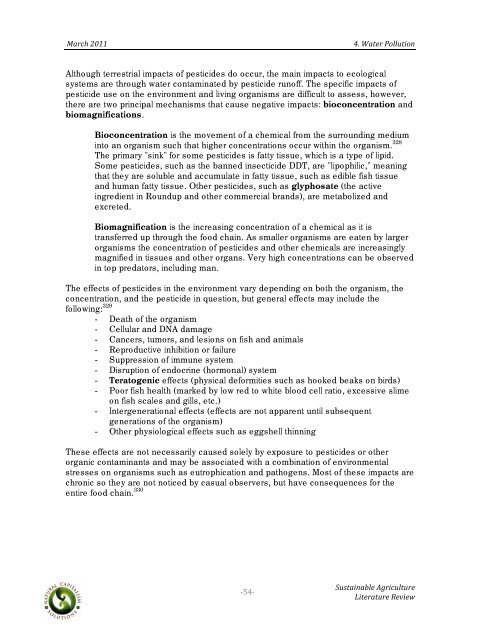Sustainable Agriculture Literature Review - Boulder County
Sustainable Agriculture Literature Review - Boulder County
Sustainable Agriculture Literature Review - Boulder County
You also want an ePaper? Increase the reach of your titles
YUMPU automatically turns print PDFs into web optimized ePapers that Google loves.
! !!<br />
"#$%&!'())!!!!!!!! !!!!!!!!!!!!!!!!!!!!!!!!!!!!!!!!!!!!!!!!!!!!!!!!!!!!!!!!!!!!!!!B=!@#-2$!CD11+-.D/!<br />
Although terrestrial impacts of pesticides do occur, the main impacts to ecological<br />
systems are through water contaminated by pesticide runoff. The specific impacts of<br />
pesticide use on the environment and living organisms are difficult to assess, however,<br />
there are two principal mechanisms that cause negative impacts: bioconcentration and<br />
biomagnifications.<br />
!<br />
Bioconcentration is the movement of a chemical from the surrounding medium<br />
into an organism such that higher concentrations occur within the organism. 328<br />
The primary "sink" for some pesticides is fatty tissue, which is a type of lipid.<br />
Some pesticides, such as the banned insecticide DDT, are "lipophilic," meaning<br />
that they are soluble and accumulate in fatty tissue, such as edible fish tissue<br />
and human fatty tissue. Other pesticides, such as glyphosate (the active<br />
ingredient in Roundup and other commercial brands), are metabolized and<br />
excreted.<br />
Biomagnification is the increasing concentration of a chemical as it is<br />
transferred up through the food chain. As smaller organisms are eaten by larger<br />
organisms the concentration of pesticides and other chemicals are increasingly<br />
magnified in tissues and other organs. Very high concentrations can be observed<br />
in top predators, including man.<br />
The effects of pesticides in the environment vary depending on both the organism, the<br />
concentration, and the pesticide in question, but general effects may include the<br />
following: 329<br />
- Death of the organism<br />
- Cellular and DNA damage<br />
- Cancers, tumors, and lesions on fish and animals<br />
- Reproductive inhibition or failure<br />
- Suppression of immune system<br />
- Disruption of endocrine (hormonal) system<br />
- Teratogenic effects (physical deformities such as hooked beaks on birds)<br />
- Poor fish health (marked by low red to white blood cell ratio, excessive slime<br />
on fish scales and gills, etc.)<br />
- Intergenerational effects (effects are not apparent until subsequent<br />
generations of the organism)<br />
- Other physiological effects such as eggshell thinning<br />
These effects are not necessarily caused solely by exposure to pesticides or other<br />
organic contaminants and may be associated with a combination of environmental<br />
stresses on organisms such as eutrophication and pathogens. Most of these impacts are<br />
chronic so they are not noticed by casual observers, but have consequences for the<br />
entire food chain. 330<br />
"&%"<br />
!*+,-#./#012!34$.%+1-+$2!<br />
5.-2$#-+$2!627.28!
















